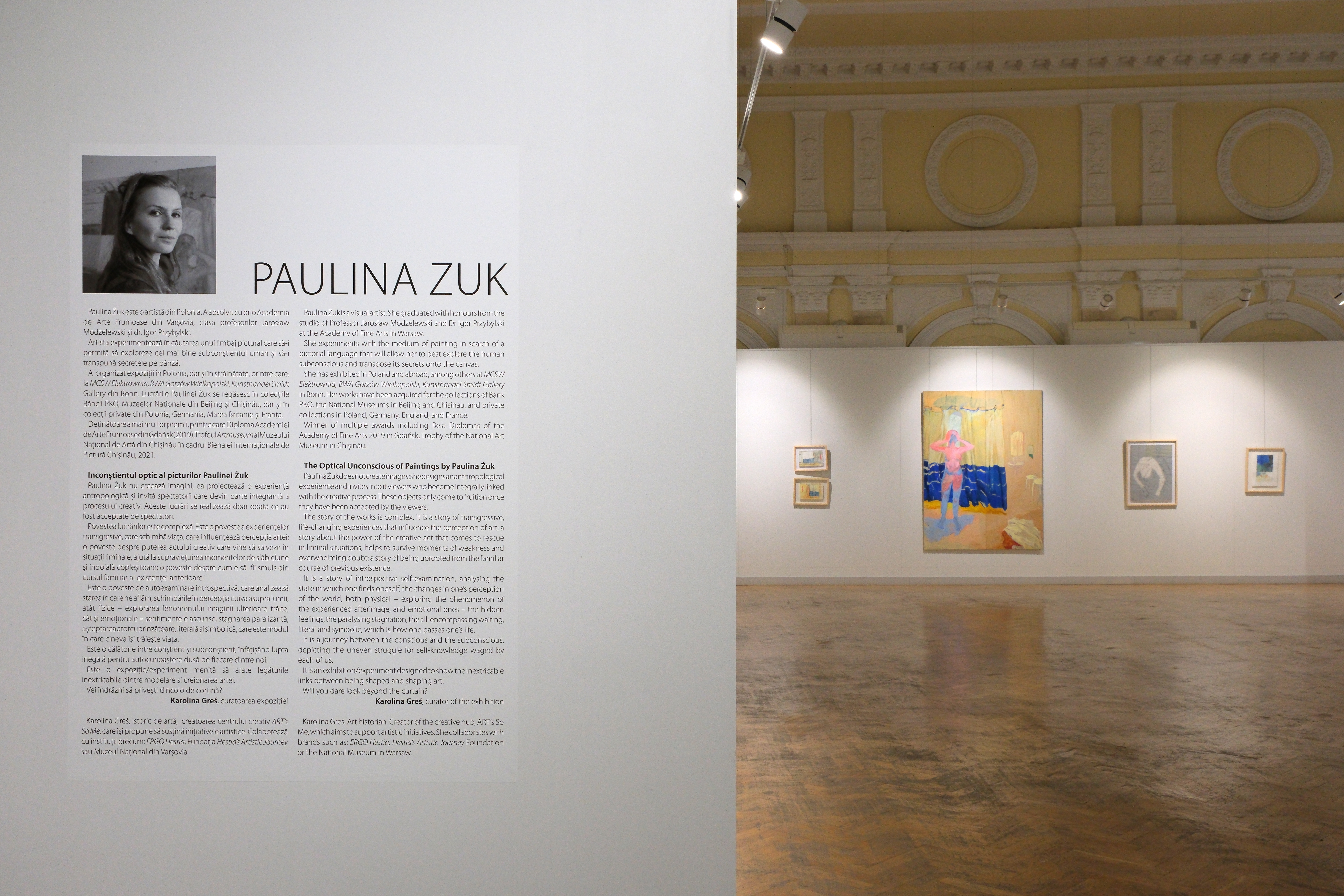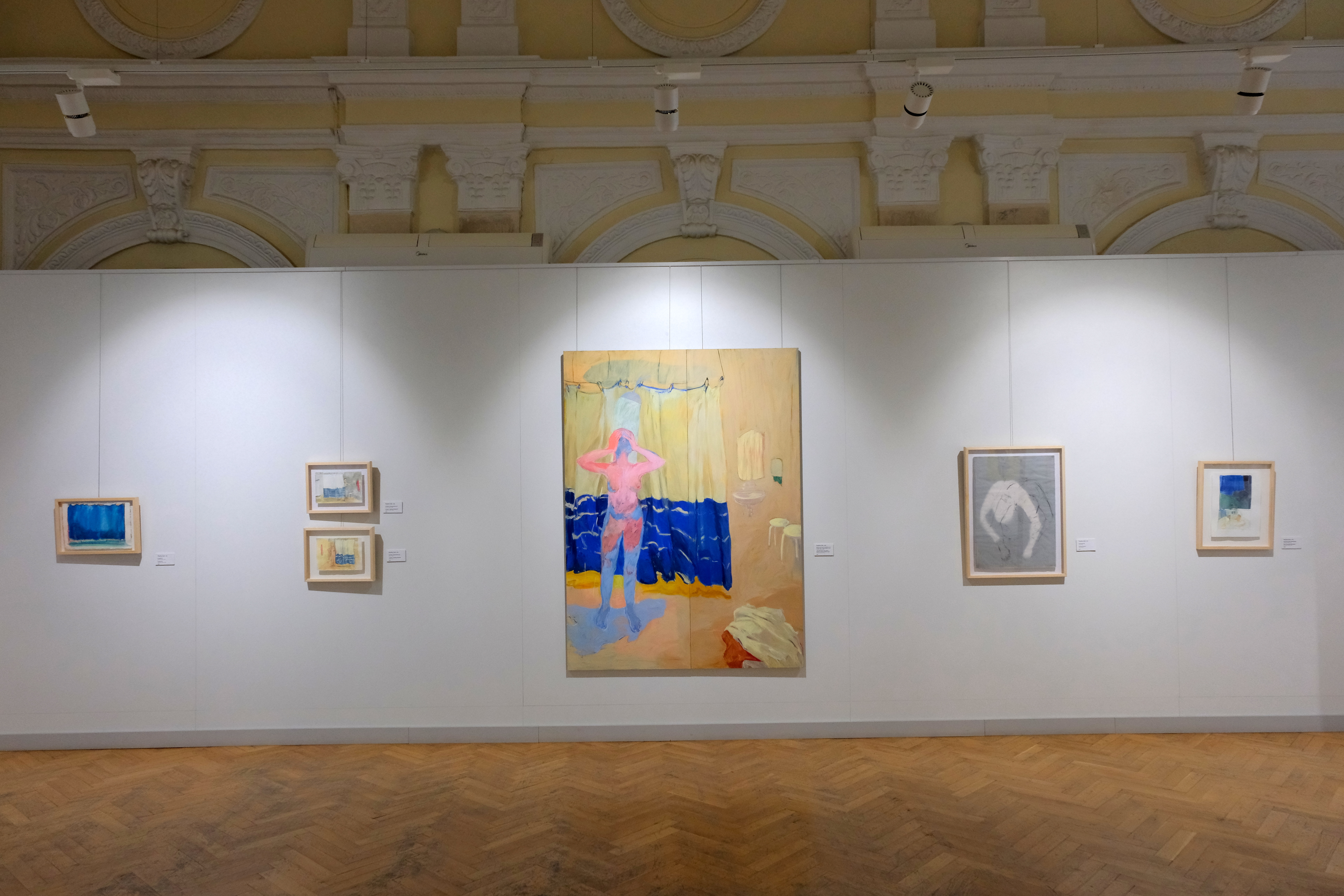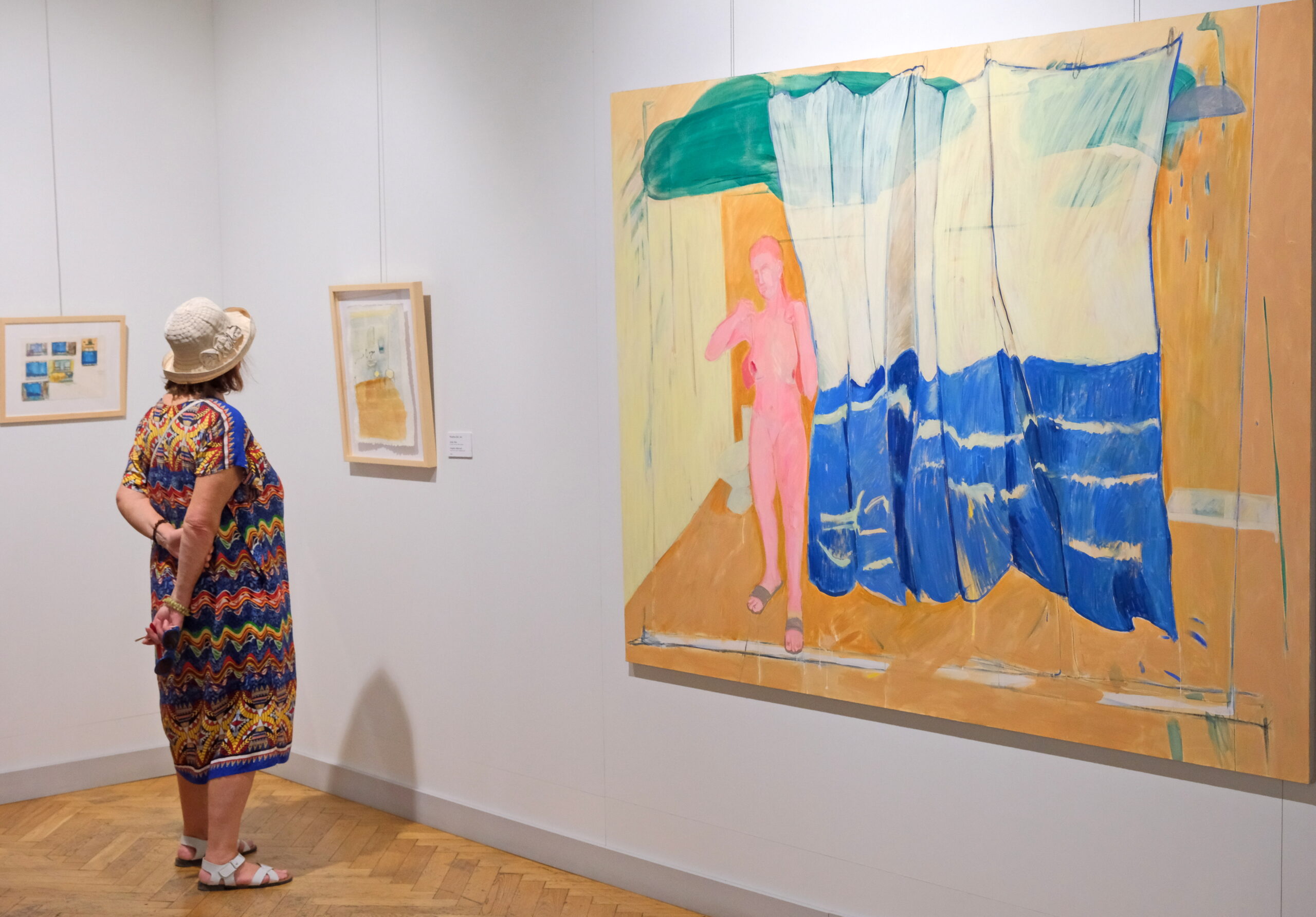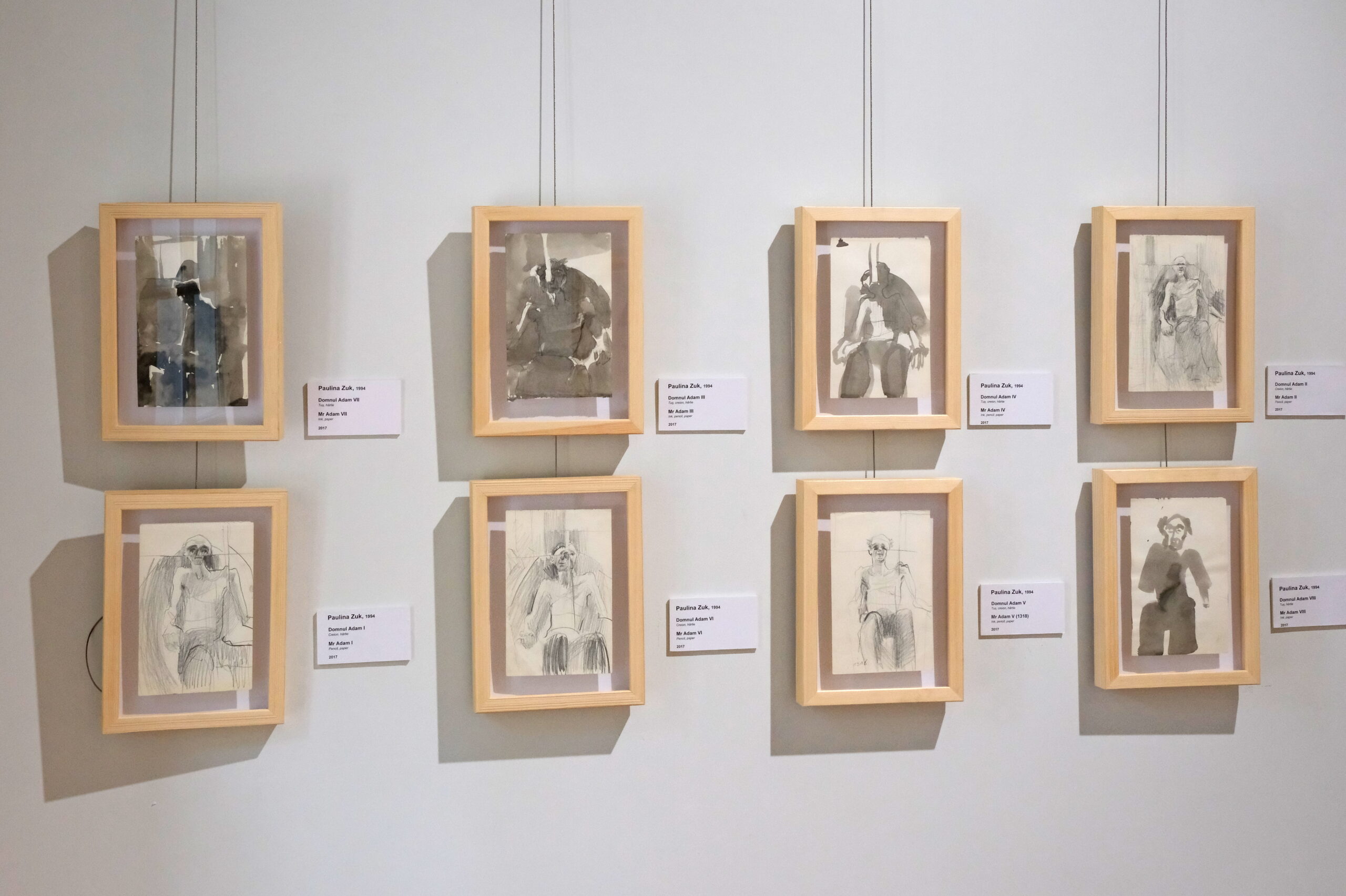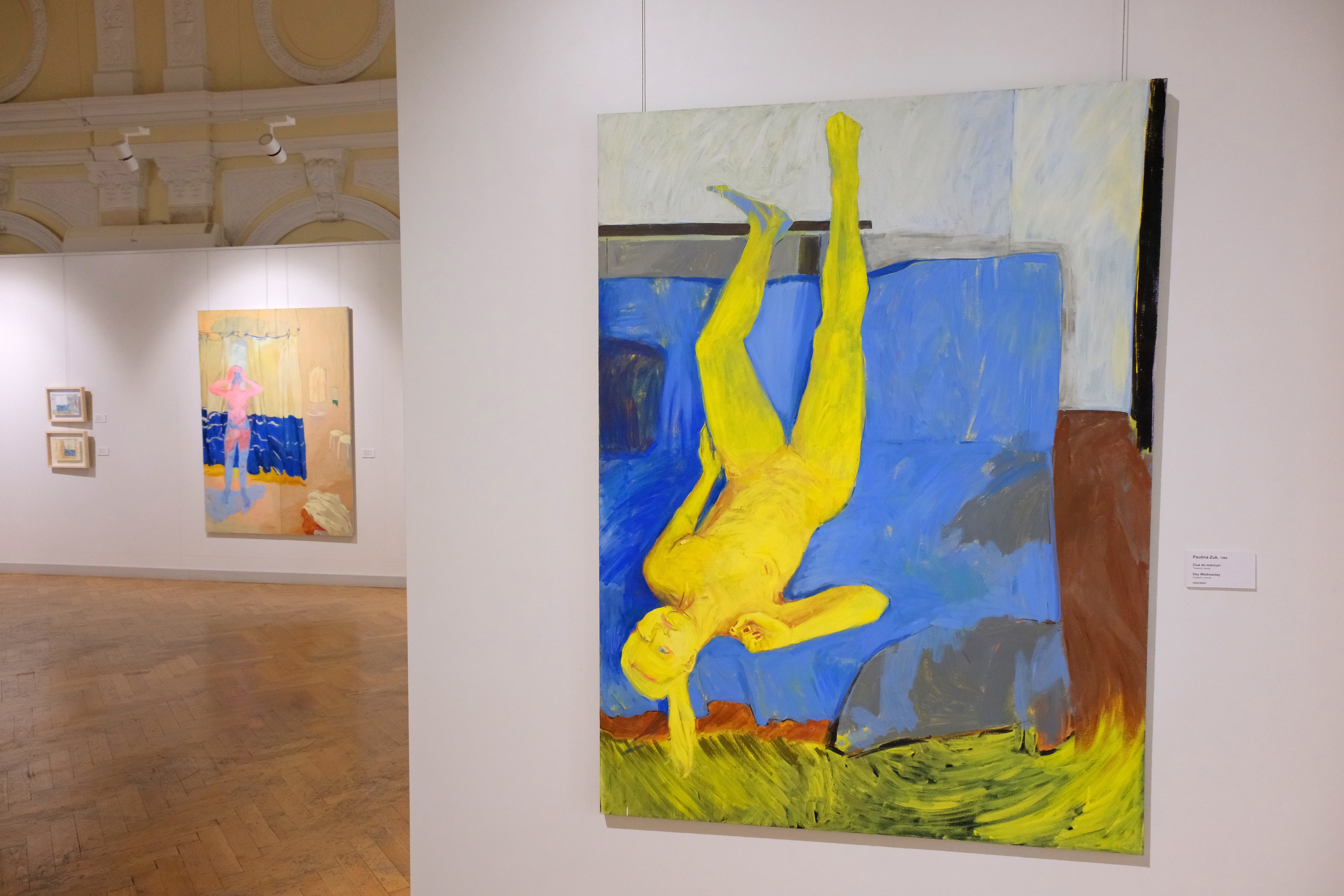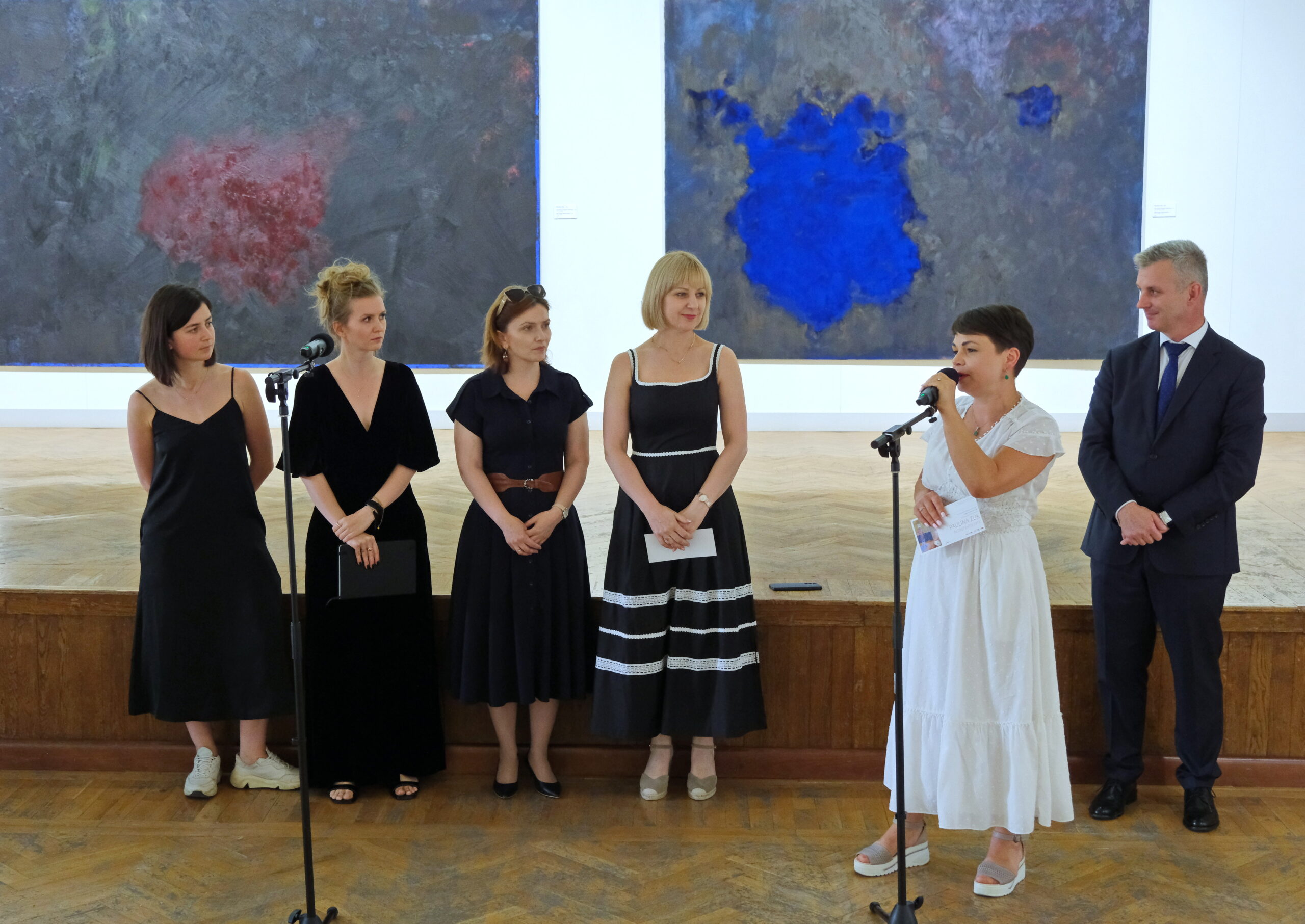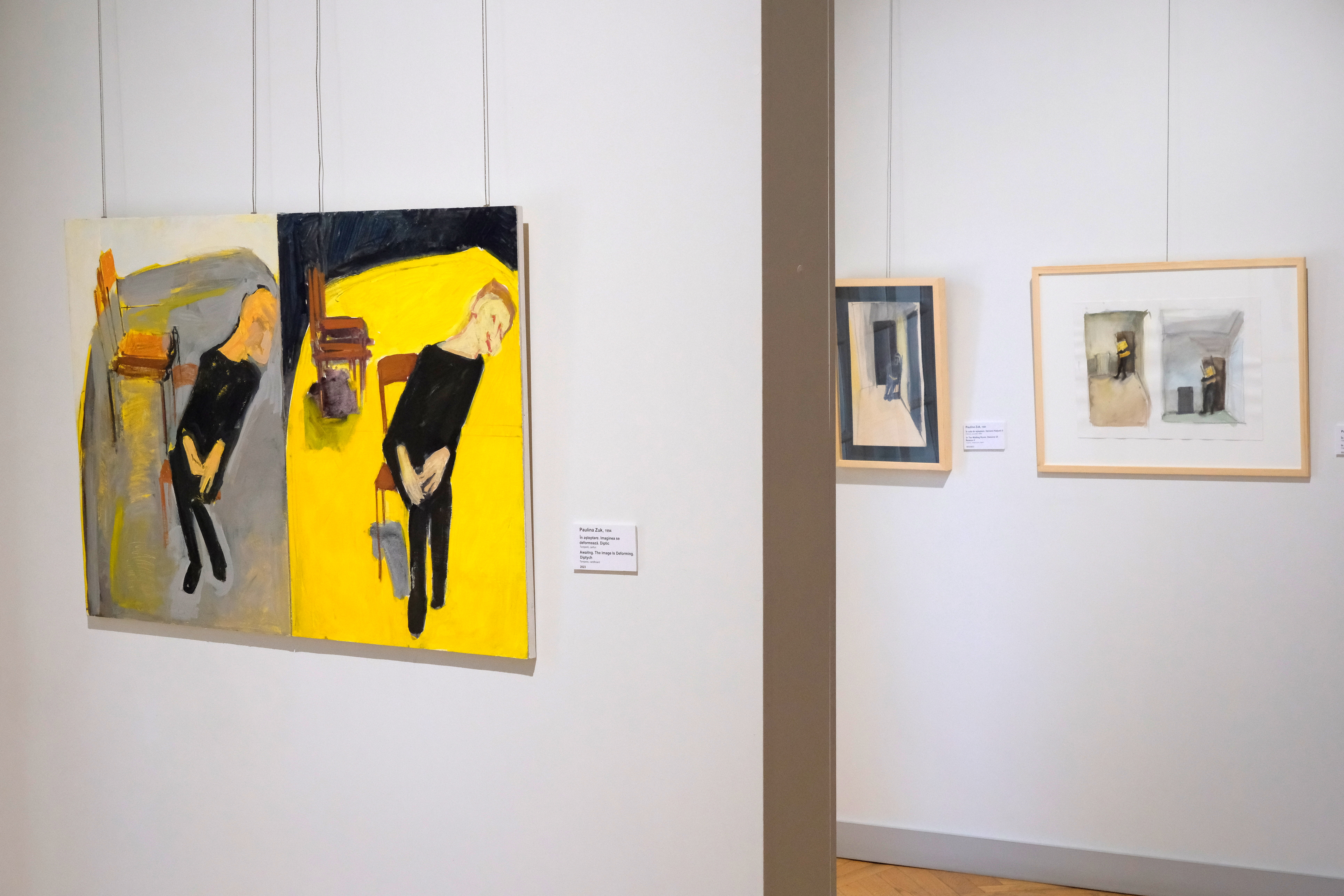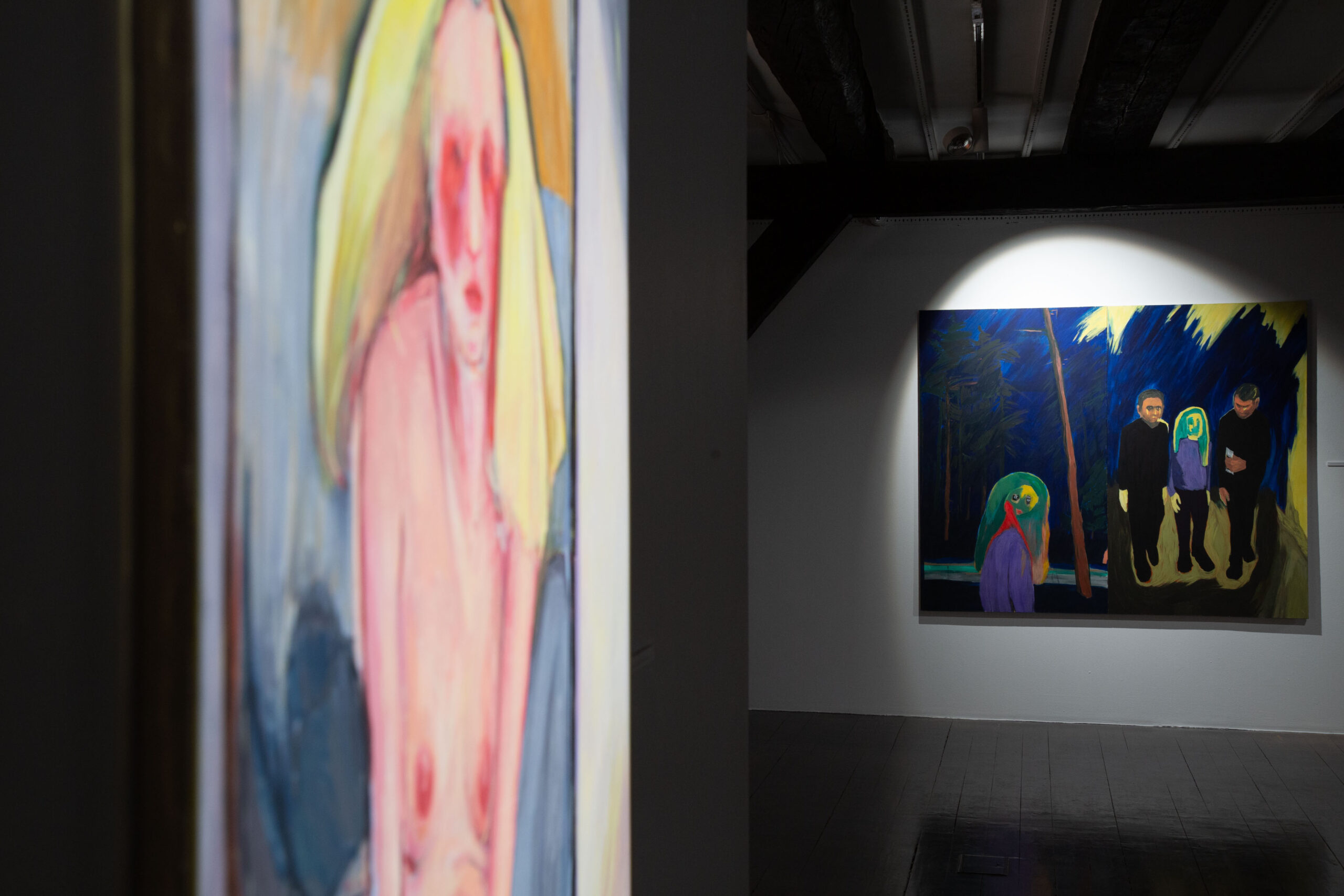GORE
kuratorka: Wiktoria Szczupacka
Galeria Wozownia, Toruń 2025
11.04.2025-11.05.2025
Wystawa Gore Pauliny Żuk skupia się na ogniu jako symbolu przemiany, destrukcji i intensywnych emocji. Ogień nie jest tu jedynie fizycznym żywiołem, ale metaforą momentów granicznych, które wpływają na percepcję i świadomość. Artystka bada, jak doświadczenia i emocje deformują sposób postrzegania rzeczywistości, tworząc powidoki psychiczne.
Paulina Żuk, inspirowana teorią powidoków Władysława Strzemińskiego, wykorzystuje malarstwo jako zapis indywidualnej percepcji i emocji. Jej obrazy nie tylko oddają wizualne ślady intensywnych przeżyć, ale także pokazują, jak silne emocje wpływają na sposób widzenia i interpretowania rzeczywistości. Dynamika barw i gestów malarskich buduje napięcie między tym, co widzialne, a tym, co odczuwalne.
Jednym z istotnych odniesień dla Gore jest prehistoryczna Cueva de las Manos – argentyńska jaskinia wypełniona setkami odcisków dłoni, w większości kobiecych. Wiele z nich ma brakujące palce, co badaczki i badacze interpretują jako możliwy ślad rytuałów przejścia, ofiary lub żałoby. Paulina Żuk nawiązuje do tej symboliki, badając, jak doświadczenie utraty i braku może stać się impulsem do twórczego aktu.
Wiktoria Szczupacka
https://paulinazuk.pl/publications
Tekst kuratorski
Wiktoria Szczupacka
Gore
Centralnym punktem wystawy Gore Pauliny Żuk jest ogień – siła zarazem niszczycielska i twórcza, konieczna do życia, a z drugiej strony nieprzewidywalna i destrukcyjna. Ogień to również pierwotna metafora transformacji, obecna w mitach i literaturze. W twórczości Pauliny Żuk reprezentuje intensywność emocji, graniczne doświadczenia i proces przemiany. Wiele kultur przypisuje ogniowi ambiwalentną rolę – od greckiego mitu o Prometeuszu, który skradł
bogom ogień jako dar cywilizacji, po symbolikę oczyszczenia i zniszczenia obecna w chrześcijańskich wizjach piekła. We współczesnej literaturze ogień często jest metaforą intensywnych przeżyć na przykład Elena Ferrante w Genialnej przyjaciółce pisała: „Było mi gorąco jak w piekle, ale jednocześnie czułam się wolna”. W nawiązaniu do tego ogień w malarstwie Pauliny Żuk nie reprezentuje jedynie fizycznego żywiołu, ale stan wewnętrzny – moment przejścia, intensywnego doświadczenia, który zmienia postrzeganie rzeczywistości. We wcześniejszej fazie twórczości artystka, inspirowana teorią powidoków Władysława Strzemińskiego, eksplorowała malarstwo jako abstrakcyjny zapis percepcji – sposób rejestrowania rzeczywistości, który jest głęboko zakorzeniony w indywidualnej fizjologii. Powidoki, powstające pod powiekami w wyniku wcześniejszego dłuższego patrzenia na intensywnie oświetlony obiekt, ujawniają, że obraz świata jaki postrzegamy, nie jest obiektywny, lecz kształtowany przez nasze zmysły i biologiczne mechanizmy widzenia, a także
widziane uprzednio obrazy. W swoich najnowszych obrazach Paulina Żuk wskazuje, jak silne emocje wpływają na deformację percepcji, stając się swoistym powidokiem psychicznym. Paulina Żuk wskazuje na doświadczenie w szerszym, także emocjonalnym tego słowa znaczeniu. Jej obrazy są nie tylko wizualnym zapisem intensywnych przeżyć, ale także próbą uchwycenia ulotnej natury emocji, które nieustannie zmieniają się pod wpływem bodźców i doświadczeń.
W Gore Paulina Żuk przenosi koncepcję powidoków na inny poziom. Jej malarstwo staje się figuratywne – przedstawia postaci, widoki bądź sceny. Wciąż jednak pozostaje medium tego, co ulotne i niemożliwe do zreprodukowania. Obecnie artystka nie skupia się jedynie na powidoku rzeczywistości, ale na oddaniu trudno uchwytnych emocji za pomocą pewnych widoków. Te, gdy są silne, osadzone w ciele, również mają moc deformowania i intensyfikowania postrzegania. Napięcie pomiędzy emocjami a widzeniem ujawnia się w ekspresyjnej materii malarskiej Żuk – w dynamicznym posługiwaniu się farbą, która nie tylko buduje obraz, ale staje się śladem gestu artystki, a także w ekspresyjnym posługiwaniu się barwą i pigmentami. Nie są one jedynie odwzorowaniem rzeczywistości, lecz narzędziem do budowania nastroju, ekspresji i symboliki. Jedną z kluczowych inspiracji dla Gore stała się prehistoryczna jaskinia Cueva de las Manos (Jaskinia Dłoni) w Argentynie. Odciski setek dłoni – w większości lewych i identyfikowanych jako kobiece – tworzą w niej malarskie archiwum nieznanych historii. Niektóre z nich są pozbawione palców, co skłania badaczki i badaczy do hipotez o rytualnych amputacjach, związanych z granicznymi momentami życia: żałobą, ofiarą, inicjacją. W tym kontekście Paulina Żuk nie tylko podejmuje temat utraty, lecz bada jej twórczy potencjał. W jej malarstwie
puste miejsca, ślady gestów stanowią aktywną część kompozycji. Odciski dłoni z Cueva de las Manos są dla niej nie tylko artefaktem przeszłości, ale także dowodem na to, że utrata może stać się medium ekspresji. Wystawa Gore koncentruje się na paradoksie kreacji poprzez utratę. Paulina Żuk analizuje, w
jaki sposób doświadczenie braku – zarówno fizycznego, jak i emocjonalnego – może stać się katalizatorem procesu twórczego. Brakujące palce dłoni „malarek” z Cueva de las Manos stają się dla artystki symbolem transformacji, dowodem na to, że utrata może prowadzić do odkrycia nowych sposobów wyrażania siebie i redefiniowania tożsamości. Gore to opowieść o twórczym potencjale silnych emocji i utraty. Tę dwoistość reprezentuje ogień – niezbędny do życia, lecz także destrukcyjny i nieprzewidywalny. Koncepcja destrukcyjnej plastyczności, sformułowana przez Catherine Malabou w jej Ontologii przypadłości. Eseju o plastyczności destrukcyjnej, dostarcza interesującego kontekstu dla interpretacji twórczości Pauliny Żuk. Malabou opisuje, jak tożsamość i forma mogą ulegać radykalnym przekształceniom w wyniku destrukcji, podkreślając, że „to, co się rozpada, nie znika – zmienia strukturę i powstaje jako coś nowego”. Podkreśla, że plastyczność to coś więcej niż elastyczność – to zdolność nie tylko do przystosowania się, ale do „wybuchowej rewolucji”, nagłej zmiany kształtu i struktury. W twórczości Pauliny Żuk można obserwować różne etapy tej przemiany. Artystka wpisuje się tym samym w szerszy dyskurs o transformacyjnej sile strat, gdzie akt twórczy wyrasta z fundamentalnej zmiany, a niekiedy nawet traumy. Nowy etap twórczości Pauliny Żuk koncentruje się tym samym na odzyskiwaniu i zapisywaniu tego co nieuchwytne – śladów pamięci, bólu, ale i siły tkwiącej w momentach z pozoru
destrukcyjnych.
Dotknęła policzków: gorące1
Maria Sobczak
Rumiane policzki. Naczynia krwionośne rozszerzają się i prześwitują przez skórę. Ta nabiera kolorytu jakby właśnie musnął ją powiew zimnego powietrza. A może to ciepło promieniuje z wewnątrz?
Ciała na obrazach Pauliny Żuk są rozgorączkowane, przechodzą przez różne stadia – od rozgrzania, przez rozpalenie aż do promieniowania nierzeczywistym światłem. Wydawać by się mogło, że zarówno artystka, jak i przedstawiane przez nią postaci, spoglądają na świat przez filtr powieki,
która przy wzrastającej temperaturze ciała, mieni się w barwach czerwieni i oranży. Jej ciężar jest wręcz przyjemny. Rzeczywistość w pracach Żuk jest podyktowana doświadczeniem ciała, które doskwiera, narzuca się, a jednocześnie jest źródłem wzruszeń i pożądania. Artystka
przygląda się raczej aktom słabego oporu, aniżeli heroicznym walkom. Zdaje się chwytać momenty, w których doszło już do rozładowania najgwałtowniejszych emocji – momenty, w których odsłania się cała gama sprzeczności i wewnętrznych przemian, które bywają
niewytłumaczalne na płaszczyźnie innej niż ciało samo w sobie. W tytułowym Gore oczy, chociaż jawią się jako małe czarne punkty, są bystre,
wpatrzone, otwarte szerzej niż mogłoby się wydawać. Czy akt uchwycenia swoich konturów na kartce papieru czyni je bardziej realnymi niż samo spojrzenie w lustro? Jakie połączenie zachodzi między tworzącą dłonią a wzrokiem ogarniającym różowo-czerwone policzki, skórę
marszczącą się w zgięciach, lekko uniesione ramiona czy rękę, pomagającą w utrzymaniu równowagi? To nie w odbiciu, a w dłoni, jej palcach wywierających nacisk na kawałek węgla zawiera się impuls. W wyniku tego tarcia, to, co cielesne i palące materializuje się na płótnie.
Dopiero oderwanie się od ciała pozwala na kojący dystans, spojrzenie z zewnątrz – to jakby być w dwóch miejscach na raz, ale w żadnym nie być w pełni. „Gore!” oznaczało dawniej „pali się!” – było komunikatem sygnalizującym nadchodzący pożar. Gdy ona gore – pali się, płonie,
błyszczy, jaśnieje, rumieni się. Jedyną, która może ją przestrzec przed tym, że jej ciało zajęło się płomieniem, jest ona sama. Usłyszane „gore!” było pobudką do ucieczki, lecz co dzieje się w przypadku, gdy ścigana i moc ją ścigająca znajdują się w tym samym ciele?
W cyklu Zasłony, który na wystawie reprezentuje obraz Znów nabrałam wody, artystka starając się pochwycić i niejako przejąć spojrzenia innych, sama staje się czułą podglądaczką. Obserwuje. To spojrzenie przenika do innych prac. Postaci multiplikują się, wnętrze miesza
się z zewnętrzem, ciało wykręca się w przeciwne strony, stopy lawirują na krawędzi. W oczekiwaniu obraz się zniekształca – pozostaje nam pytać – na co właściwie czekamy? Nawet czujne oko ulega zmęczeniu – skupienie na szczegółach przestaje być istotne, gdy intuicja
podpowiada, że patrzy się na coś niepojmowalnego. Oczekiwanie staje się próbą uchwycenia nie tyle całościowego charakteru wydarzeń mknących przed oczami, ile afektu, który je poprzedza. W samej materii malarskiej leży już konkretna decyzja. Wybór dużych formatów i
techniki tempery jajowej narzuca artystce konkretne tempo pracy, zmuszając ją do oddalania się i powracania w przestrzeń wydarzeń rozgrywających się na płótnie. Natomiast farba olejna oferuje większą wolność – wyzwala dzikość i gwałtowność. W obydwu przypadkach afekt
wymyka się poznaniu, nie pozwala się nadto analizować, zmienia swoje oblicze prowokując do wielokrotnego przemalowywania pojedynczego obrazu, to znów znika z pola widzenia, gdy proces przyspiesza. W efekcie światy przedstawione w obrazach Pauliny Żuk pozostają
autonomicznymi przestrzeniami mentalnymi ich bohaterek i bohaterów. Eksplorację tego, co nieuchwytne, artystka podejmuje także w pracach rzeźbiarskich. Zasłyszana historia o Jaskini Dłoni (Cueva de las Manos), której kamienne, chropowate ściany
pokrywają odciski dłoni z odciętymi poszczególnymi palcami staje się bodźcem do powstania ceramicznej instalacji. Palce te miały być odcinane przez kobiety w żałobie po stracie bliskiej osoby. Poszukiwania informacji potwierdzającej prawdziwość tego zwyczaju kończą się
niepowodzeniem. Sama historia, chociaż oscyluje na granicy prawdy i kreacji, jest jednak zbyt kusząca, aby z niej zrezygnować. Próba uchwycenia czegoś tak odległego nie wynika z potrzeby utożsamienia się z ich doświadczeniem i zrozumienia go. Potencjalność tej opowieści
kryje się w solidarności wykraczającej poza to co nam znane. Ciepła dłoń obrabia glinę w czułym akcie, eksplorując różnorodność możliwych kształtów. Chociaż w każdym procesie twórczym kryje się odrobina zachłanności, artystka rzeźbiąc palec po palcu, przenosi uwagę
ze zbędnych pytań i odpowiedzi, na zwykłe towarzyszenie emocjom zawartym w tej historii.
Twórczość Pauliny Żuk przenika refleksja nad towarzyszeniem – samej sobie, kobietom, które odciskały swoje dłonie w jaskini, swoim siostrom, żółwiom i rybom w brzuchu, tym, z którymi wiele nas łączy i tym, z którymi wszystko nas dzieli. Patrząc na obrazy
artystki, możemy zastanowić się nad tym, jak towarzysząc generować troskę, która rozgrzewa, ale nie parzy. Zimowanie sióstr daje się czytać właśnie jako oda do ciepła, które rodzi się z bliskości dwóch siostrzanych ciał. Marzenie o hibernacji wpisuje się w potrzebę chociaż
chwilowego wyłączenia ciała, słodkiej nieświadomości, na którą biologiczny rytm człowieka pozwala tylko we śnie. Równomierny ruch klatki piersiowej siostry pozwala na synchronizację oddechów, wdechy i wydechy następują po sobie spokojnie. Ciepłe powietrze otula, a nadchodzący sen pozwala na przetrwanie – zimy i wszystkiego, co przyjdzie razem z nią.
1 M. Kuncewiczowa, Cudzoziemka, Wydawnictwo Marginesy, Warszawa 2023
The Optical Subconscious
27.06.2023-27.08.2023
solo exhibition in National Art Museum in Moldova
The Optical Subconscious of Paintings by Paulina Żuk
I enter the picture as a cast shadow, cast because, dumbly, I get in the way of the light. And because I get in the way of it, I cannot see it. The point where it would be, if I could see it, is held for me by a marker, a placeholder, a structural substitute. This is the automaton, the readymade, the thing the gap both produces and hides behind. This is what marks the point in the optical system where what is thought to be visible will never appear.
Jacques Lacan
How to show those aspects of reality that, while remaining unconscious to our everyday perception, have a tangible impact on us? Rosalind Krauss saw in the “optical unconscious” the potential of art to reveal what is usually hidden: layers of meaning located beyond consciousness.
Paulina Żuk’s fascination with the exploration of the border between these two states and its permeability is fundamental to her artistic practice. She does not create objects; she projects an anthropological experience: the paintings can only be fully completed once they are accepted by the viewers. The painter believes that the viewers are integrally connected to the creative process.
The narrative of the exhibition is centred around the two series, Curtains and Afterimage, and is complemented among others by works from the series Mr Adam, Animal, In the Waiting Room. Monumental canvases are juxtaposed with works on paper and sketches in order to reconstruct the creative act, full of experimentation and discovery of the most accurate form, to show the dynamics of the process, and to illustrate the complexity of the experienced states.
The story of the works is complex. It is a story of transgressive, life-changing experiences that influence the perception of art; a story about the power of the creative act that comes to rescue in liminal situations, helps to survive moments of weakness and overwhelming doubt; a story about introspective self-examination, analysing the state in which one finds oneself, the changes in one’s perception of the world, both physical – exploring the phenomenon of the experienced afterimage, and emotional ones – the hidden feelings, the stagnation, the all-encompassing waiting that mercilessly consumes our lives. Above all, it is a journey between the conscious and the subconscious, depicting the uneven struggle for self-knowledge waged by each of us.
Curtains are symbolic curtains that separate us from cognition. Both art and dreams are based on the subjective readymade: tangled stories and histories that both surround us and are adopted as our own, building our self-awareness. Żuk performs an artistic transposition of the phenomenon of secondary revision of dreams. However, rather than constructing a mirage façade based on scraps of our memories, she processes the oftentimes chaotic impressions and feelings that accompany our existence, hoping to unmask our subconscious.
For Żuk, this is a balancing act between figurative images, which are sometimes phantasmagorical, and lyrical abstractions. She blurs the boundary between the real and the illusory. She reaches for the strongest feelings in an attempt to point out the inner tremors and inconsistencies we have to live with. In her figurative works, Żuk shows people plunged into extreme emotional states, either locked inside themselves, shrunken, cut off from the world, or caught in the liminal moments of their lives: suffering leading to disintegration but also primal desire that belies social norms. Afterimages are hypnotic; by interacting with colour and texture, they activate receptors in the brain, leading to a distortion of reality. Will we panic when we lose control of our senses? Or will we begin to analytically look into that state? Will it allow us to discover feelings that we are not usually aware of? Like searching for a Lacanian “structured unconscious”, reflecting the trauma resulting from a would-be encounter, a gap that separates us from a loss, an unknowable thing, the painter projects an experience of emptiness, a self-inflicted damage that is supposed to take us to the core of our identity.
The exhibition is designed to show the inextricable links between being shaped and shaping art.
Will you dare look beyond the curtain?
curator Karolina Greś
translated by Marcin Łakomski
Optyczna podświadomość malarstwa Pauliny Żuk
„Wkraczam do obrazu jak rzucany cień, rzucany, ponieważ niemy; dostaję się tam na sposób światła. A ponieważ dostaję się na jego sposób, nie mogę go widzieć. Punkt, w którym by się znajdowało, gdybym mógł je widzieć, jest trzymany dla mnie przez oznacznik, korelat, strukturalny substytut. To jest automaton, readymade, rzecz którą luka zarówno produkuje, jak i skrywa za sobą. To jest to, co zaznacza punkt w systemie optycznym, gdzie to, co się uważa za widzialne, nigdy się nie pojawi.”
Jacques Lacan
Jak pokazać te aspekty rzeczywistości, które pozostając nieuświadomionymi dla naszej codziennej percepcji, mają na nas wymierny wpływ? Rosalind Krauss w „optycznej podświadomości” upatrywała potencjału sztuki do odsłaniania tego co zwykle przed nami ukryte – warstw znaczeń, sytuujących się poza świadomością.
Fascynacja eksploracją granicy i jej przepustowości pomiędzy tymi dwoma stanami jest fundamentem działalności artystycznej Pauliny Żuk. Nie tworzy ona obiektów, a projektuje antropologiczne przeżycie - obrazy dopełnią się w pełni dopiero po ich przyjęciu przez widzów. Malarka wierzy, że odbiorcy są integralnie związani z procesem twórczym.
Narracja wystawy skoncentrowana została wokół dwóch cykli „Zasłon” i „Powidoku”, a dopełniają ją m.in. prace z serii „Pan Adam”, „Zwierz”, „W poczekalni”. Zderzono ze sobą monumentalne płótna z pracami na papierze oraz szkicami, by dokonać rekonstrukcji aktu twórczego, pełnego eksperymentów i odkrywania najtrafniejszej formy, ukazać dynamikę procesu, ale i zobrazować złożoność doświadczanych stanów.
Historia prac jest złożona - to opowieść o transgresyjnych doświadczeniach zmieniających życie, wpływających na percepcję i postrzeganie sztuki. Opowieść o potędze aktu twórczego, stanowiącym ratunek w sytuacjach granicznych, pozwalającym przetrwać chwile słabości i wszechogarniającego zwątpienia. Opowieść o introspekcyjnym przyglądaniu się sobie, dokonującym się zmianom, zarówno tym fizycznym – eksplorowaniu doświadczanego zjawiska powidoku, jak i tym emocjonalnym – skrywanym uczuciom, marazmowi, przeszywającemu oczekiwaniu, które pochłania bezlitośnie nasze życie. Przede wszystkim jest to jednak podróż pomiędzy świadomością a podświadomością, obrazującą nierówną walkę o poznanie samego siebie, którą toczy każdy z nas
„Zasłony” to symboliczne kotary oddzielające nas od poznania. Zarówno sztuka, jak i sny oparte są na podmiotowym readymade, czyli splotach opowieści i historii, które zarówno nas otaczają, jak i są przez nas przyjmowane jako własne, budując naszą samoświadomość. Żuk dokonuje artystycznej transpozycji zjawiska wtórnej rewizji snu, przy czym nie konstruuje rzeczonej fasady miraży w oparciu o strzępy naszych wspomnień, a przetwarza nieraz chaotyczne wrażenia i odczucia towarzyszące naszej egzystencji, dążąc do zdemaskowania naszej podświadomości.
W przypadku Żuk przyjmuje to formę balansowania pomiędzy wizerunkami figuratywnymi, niekiedy przybierającym ton fantasmagoryczny, a abstrakcjami lirycznymi. Zaciera ona granice pomiędzy tym co realne a złudne. Sięga po najsilniejsze uczucia, starając się wskazać na wewnętrzne rozedrgania i niespójności, z którymi przyszło nam żyć. Żuk w swoich figuratywnych pracach pokazuje ludzi pogrążonych w skrajnych stanach emocjonalnych, albo zamkniętych w sobie, skurczonych, odciętych od świata, albo uchwyconych w granicznych momentach swojego życia – cierpieniu prowadzącym do rozpadu, ale i pierwotnego pożądania, zadającego kłam społecznym normom. Powidoki hipnotyzują nas, poprzez oddziaływanie barwą i fakturą uruchomiają receptory w naszym mózgu, prowadzące do wypaczenia naszej rzeczywistości. Czy poczujemy panikę tracąc kontrolę nad naszymi zmysłami? Czy może zaczniemy analitycznie przypatrywać się temu stanowi? Czy pozwoli nam odkryć uczucia, których zwykle nie jesteśmy świadomi? Niczym poszukując lacanowskiej „nieświadomości strukturalnej”, odzwierciedlającej traumę wynikającą z niedoszłego spotkania, luki, która oddziela nas od straty, niepoznanej rzeczy - malarka projektuje doświadczanie pustki, samookaleczenia, które ma nas doprowadzić do dotarcia do sedna naszej tożsamości.
Wystawa ta ma za zadanie pokazywać nierozerwalne związki pomiędzy byciem kształtowanym a kształtowaniem sztuki.
Czy odważysz się wyjrzeć poza zasłonę?
Karolina Greś
.
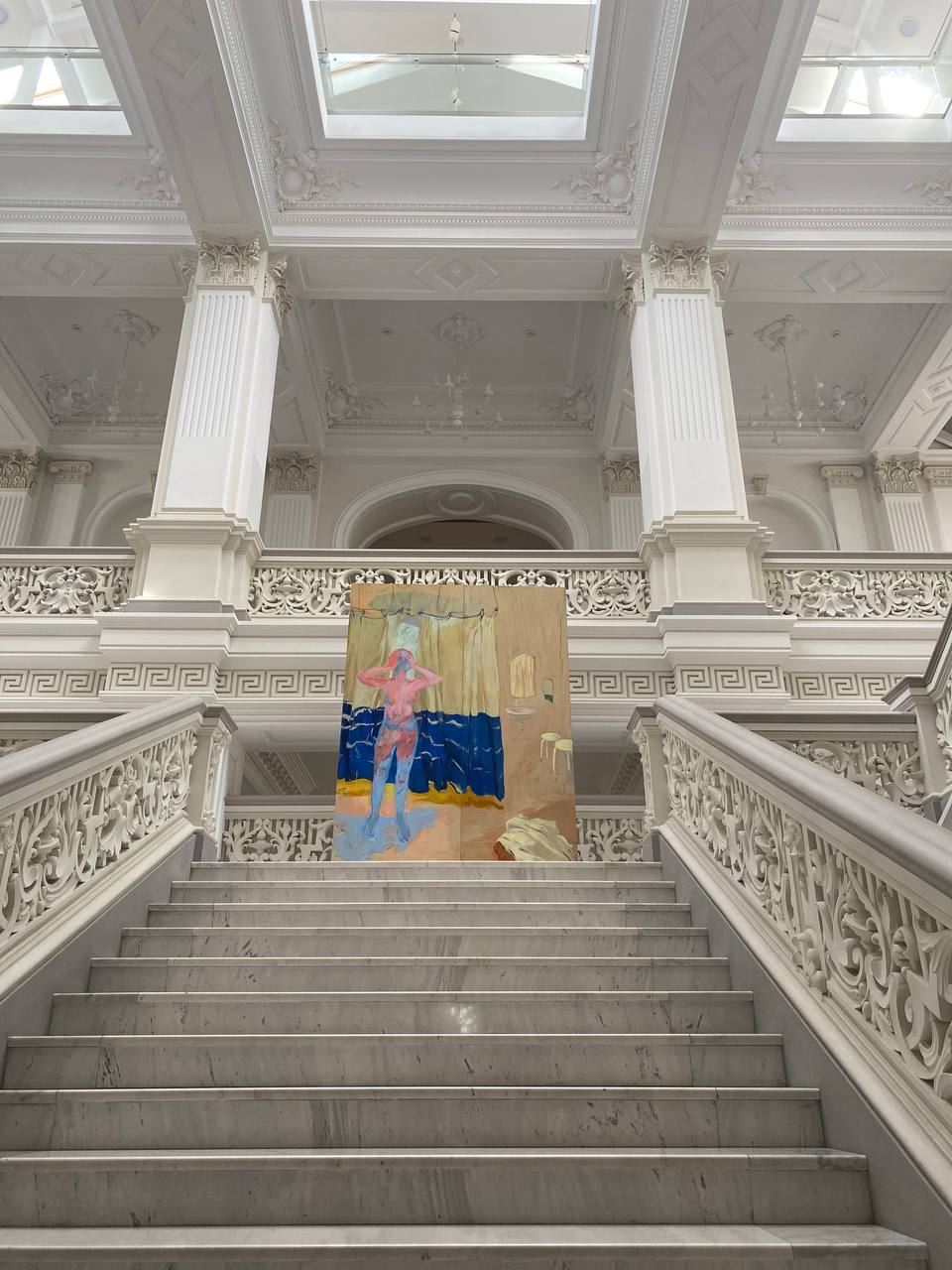
.
